Kapurthala State
Kapurthala State, with its capital at Kapurthala, was a former Princely state of the Punjab Province of India. Ruled by Ahluwalia Sikh rulers, spread across 510 square miles (1,300 km2). According to the 1901 census the state had a population of 314,341 and contained two towns and 167 villages.[1] In 1930, Kapurthala became part of the Punjab States Agency and acceded to the Union of India in 1947.
Kapurthala State | |||||||||
|---|---|---|---|---|---|---|---|---|---|
| 1772–1947 | |||||||||
 Flag
 Coat of arms
| |||||||||
 Kapurthala State in Punjab Province, 1909. | |||||||||
| Historical era | New Imperialism | ||||||||
• Established | 1772 | ||||||||
• Part of the Punjab States Agency | 1930 | ||||||||
• Accession to the Indian Union | 1947 | ||||||||
| Area | |||||||||
| 1901 | 1,320 km2 (510 sq mi) | ||||||||
| Population | |||||||||
• 1901 | 314,341 | ||||||||
| |||||||||
| Today part of | Punjab, India | ||||||||
In colonial India, Kapurthala State was known for its communal harmony, with its Sikh ruler Jagatjit Singh building the Moorish Mosque for his Muslim subjects.[2] At the time of the Indian independence movement, the ruler of the Kapurthala State opposed the partition of India and advocated for a united, secular country.[3]
Origins
The ruling dynasty of Kapurthala originated in the Ahluwalia misl. According to this account, Krishna's descendant Gaj built the fort of Gajni, and lost his life in a battle against a joint Roman-Khorasani army. His son Salibahan established the city of Sialkot, and started the Shak era after defeating the Shaks in 78 CE.
After the Muslim conquest of Punjab, his descendants migrated to the Jaisalmer area, where they came to be known as Bhatti Rajput tribe. After Alauddin Khalji's conquest of Jaisalmer, some of the Bhatti tribe people's migrated to Tarn Taran district, mingled with Jats. Gradually, they came to be known as Jats, and in the 17th century, they joined Guru Hargobind's army. Ganda Singh of this family raided Lahore, whose governor Dilawar Khan persuaded him to join the Lahore army, and assigned him the fief of Ahlu and some other villages. Ganda Singh's son Sadhu (or Sadho) Singh lived in Ahlu, because of which the family came to be known as Ahluwalia. Sadhu Singh and his four sons married into Kalal families, because of which the family came to be known as Ahluwalia. The descendants of Sadhu Singh son Gopal Singh (who was the grandfather of Jassa Singh) established the royal family of Kapurthala.[4] The British administrator Lepel Griffin (1873) dismissed this account as spurious.[4] The Sikh author Gian Singh, in his Twarikh Raj Khalsa (1894), wrote that the Ahluwalia family adopted the Kalal caste identity much before Sadhu Singh.[5]
The Ahluwalia misl rose to prominence under Jassa Singh Ahluwalia,[6][7] who was the first person to use the name "Ahluwalia". Originally known as Jassa Singh Kalal, he styled himself as Ahluwalia after his ancestral village of Ahlu and belonged to the Kalal community.[8] He is regarded as the founder of the Kapurthala State.[9]
Even after other misls lost their territories to Ranjit Singh's Sikh Empire, the emperor permitted the descendants of Jassa Singh to retain their estates. After the British took over the Sikh territories in 1846, Jassa Singh's descendants became the ruling family of the Kapurthala State.[10]
Religion
| Religion | Population | Percentage |
|---|---|---|
| Islam |
213,754 | 56.49% |
| Sikhism |
88,350 | 23.35% |
| Hinduism |
61,546 | 16.27% |
| Christianity |
1,643 | 0.43% |
| Others[lower-alpha 2] | 13,087 | 3.46% |
| Total Population | 378,380 | 100% |
Royal dynasty
List of rulers
| No. | Name
(Birth–Death) |
Portrait | Reign | Ref. |
|---|---|---|---|---|
| Sardars | ||||
| 1 | Jassa Singh Ahluwalia (1718–1783) |
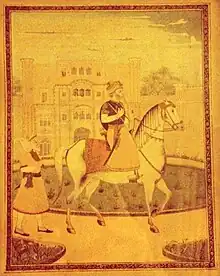 |
1777 – 20 October 1783 | [12][13] |
| 2 | Bagh Singh Ahluwalia (1747–1801) |
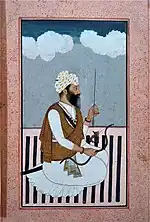 |
20 October 1783 – 10 July 1801 | |
| Rajas | ||||
| 3 | Fateh Singh Ahluwalia (1784–1837) |
 |
10 July 1801 – 20 October 1837 | [14][15][16] |
| 4 | Nihal Singh (1817–1852) |
 |
20 October 1837 – 13 September 1852 | |
| 5 | Randhir Singh (1831–1870) |
 |
13 September 1852 – 12 March 1861 | [13] |
| Raja-i Rajgan | ||||
| – | Randhir Singh (1831–1870) |
 |
12 March 1861 – 2 April 1870 | [13] |
| 6 | Kharak Singh (1850–1877) |
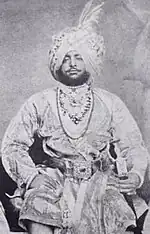 |
2 April 1870 – 3 September 1877 | |
| 7 | Jagatjit Singh (1872–1949) |
 |
3 September 1877 – 12 December 1911 | [13] |
| Maharajas | ||||
| – | Jagatjit Singh (1872–1949) |
 |
12 December 1911 – 15 August 1947 | [13] |
| Titular | ||||
| – | Jagatjit Singh (1872–1949) |
 |
15 August 1947 – 19 June 1949 | [13] |
| 8 | Paramjit Singh | |||
| 9 | Sukhjit Singh | 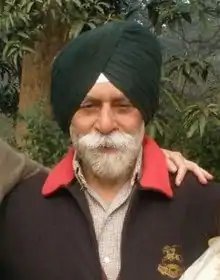 |
||
Crown Princes
- Tikka Raja Shatrujit Singh[3]
Dewan/ Ministers Of Kapurthala State
- Dewan Banna Mal Gautam ( Manager Of Oudh Estates of Maharaja Kapurthala)
- Dewan Mathra Dass ( Private Secretary)
- Dewan Ramjas Dhir
- Dewan Acchru Mal Gautam ( Revenue Minister) s/o Dewan Banna Mal
- Dewan Durga Dass Gautam
- Dewan Ambika Parshad Gautam( Accountant General )
- Dewan Mohabbat Rai
- Dewan Abdul Hamid ( Prime Minister)
- Dewan Shiv Narayan Randev ( Chief Secretary Of Kapurthala State )
- Sirdar Bhagat Ram Randev ( Chief Judge)
- Sirdar Dwarka Dass Randev , Bar At Law S/O Dewan Shiv Narayan Randev ( Assitant Manager OUDH And Last Chief Justice Of Kapurthala State
- Dewan Hari Chand Chopra ( Finance Minister)
- Dewan Saudagar Mal
- Dewan Badrinath
- Dewan Surendranath
- G.T Fisher ( Chief Minister)
- Dewan Sureshwar Dass ( Home Minister)
- Dewan Ajudhia Dass ( Revenue Minister)
- Sirdar Suchet Singh
- Sirdar Kishan Singh
- Dewan Raj Kumar Chopra ( Chief Justice )
- Dewan Jermany Dass
- Dewan Kuljass Rai
Gallery
 Qila Jallow Khana, Kapurthala State
Qila Jallow Khana, Kapurthala State Old Baradari at Shalimar Garden, Kapurthala State
Old Baradari at Shalimar Garden, Kapurthala State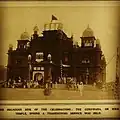 Photograph of the State Gurdwara of Kapurthala State during a thanksgiving service
Photograph of the State Gurdwara of Kapurthala State during a thanksgiving service Old court complex , Kapurthala State
Old court complex , Kapurthala State Photograph of Buggy Khana, Kapurthala State
Photograph of Buggy Khana, Kapurthala State
Notes
- Including Ad-Dharmis
- Including Jainism, Buddhism, Zoroastrianism, Judaism, Tribals, others, or not stated
References
- Kapurthala state The Imperial Gazetteer of India, 1909, v. 14, p. 408.
- Venkatesh, Karthik (16 January 2016). "Malerkotla, Where Tolerance is a Way of Life". The Wire. Retrieved 3 November 2020.
- "An undivided India?". NDTV. 29 August 2009. Retrieved 19 October 2020.
- Ganda Singh (1990). Sardar Jassa Singh Ahluwalia. Punjabi University. pp. 1–4.
- M. L. Ahluwalia (1996). Land marks in Sikh history. Ashoka International. p. 37.
- Kaushik Roy (2015). Military Manpower, Armies and Warfare in South Asia. Routledge. p. 88. ISBN 9781317321279.
- Singhia, H.S. (2009). The encyclopedia of Sikhism. New Delhi: Hemkunt Press. p. 111. ISBN 978-81-7010-301-1.
- Donald Anthony Low (1968). Soundings in Modern South Asian History. University of California Press. pp. 70–71. OCLC 612533097.
- Sohan Singh Seetal (1981). The Sikh Misals and the Punjab States. Lahore Book Shop. p. 75.
- W. H. McLeod (2009). The A to Z of Sikhism. Scarecrow Press. p. 6. ISBN 978-0-8108-6344-6.
- "CENSUS OF INDIA, 1941 VOLUME VI PUNJAB PROVINCE". Retrieved 17 January 2023.
- "Kapurthala". Archived from the original on 8 August 2018. Retrieved 11 March 2019.
- "KAPURTHALA". Royal Family of India. 12 April 2013. Retrieved 9 January 2018.
- "History | Kapurthala Web Portal | India". Government of India. Retrieved 25 December 2020.
- A history of the Sikhs, from the origin of the nation to the battles of the Sutlej. Cunningham, Joseph Davey, 1812-1851., Garrett, H. L. O. ed. (Herbert Leonard Offley), 1881-1941
- Griffin, Lepel Henry (1892). Ranjit Singh. Oxford : Clarendon press.
External links
 Media related to Kapurthala State at Wikimedia Commons
Media related to Kapurthala State at Wikimedia Commons- Kapurthala www.sikh-heritage.co.uk